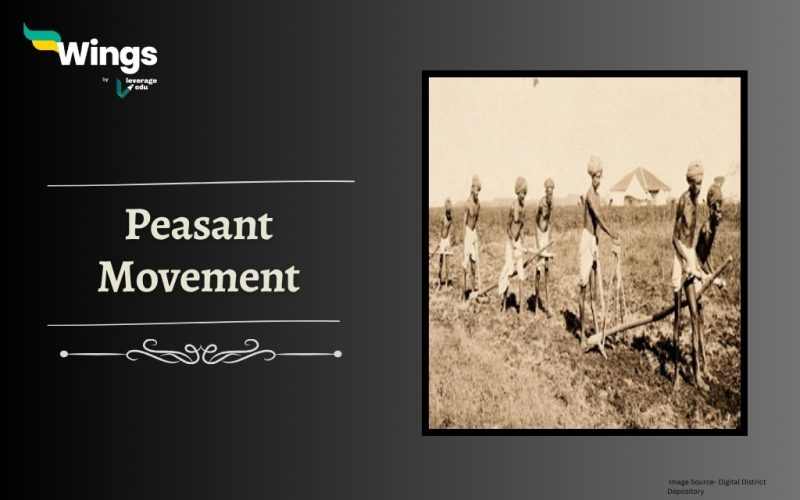Peasant movements have played a significant role in shaping the history of India, especially in the fight against land rights and agricultural reforms. Starting from the pre-independence era, the Indian national movement and to modern times, these movements have brought the struggles of rural agrarian communities to the mainstream with issues such as demanding justice, fair treatment, and improved living conditions. In this article, we will explore these peasant movements and how they impacted the present socio-economic conditions of the country.
Table of Contents

What were the Causes of Peasant Movements in India?
In the 18th and 9th centuries, the peasant movements included social struggles against the atrocities of the British colonial system. The handicrafts of the peasants were ruined. There were many more causes which resulted in the uprising of the peasant movement. Some of them are –
- Exploitation by Moneylenders – Peasants especially small and marginal farmers, often faced the exploitative and extortionate practices by moneylenders. High interest rates, lack of credit facilities, and harsh debt repayment pushed the peasants into the vicious cycle of poverty and indebtedness.
- Land Reforms – One of the major concerns of peasants has been the unequal distribution of land. Large landholdings by a few wealthy landowners or institutions have left the majority of peasants landless or with meagre holdings. This disparity has led to the demand for land reforms and redistribution of land to benefit the rural class, resulting in the uprising of peasants.
- Inequitable Resource Allocation – The lack of access to basic resources such as irrigation facilities, seeds, fertilizers and credit has hampered the growth and productivity of peasants. Movements have sought to challenge the unequal distribution of resources and demand government intervention to address these disparities.
- Oppressive Agrarian Policies – Peasant uprisings had risen in response to oppressive agrarian policies, including unfair taxation, high land revenue rates and forced eviction from lands. These policies have marginalised the rural class and led to protests and demands for policy reform.
Also Read – Salt Satyagraha Movement: Definition, Causes, Effects
Phases of Peasant Movements in India
There are two phases of the Peasant Movement that can be broadly classified as follows:
- First Phase: It is the Peasant Movement before 1857.
- Second Phase: It is the Peasant Movement after 1857.
List of Early Peasant Rebellion in the 18th and 19th Century (Pre-Gandhian phase)
| Peasant Movements | Year | Details of the Movement |
| Sanyasi Revolt | 1763-1800 | 1. This revolt took place in Bengal. 2. The Sanyasi Revolt was led by Maznoom Shah and supported by Bhawani Pathak and Devi Choudhurani. 3. The Sanyasi Revolt ignited a rebellion among landless peasants as it displaced the rich zamindars. 4. Sanyasi and Fakirs joined the Bengal Famine in 1770. |
| Narkelberia Uprising | 1782-1831 | 1. Inspired by Mir Nithar Ali or Titu Mir. 2. It started in West Bengal 3. The rise was against landlords, mainly Hindus, who imposed a beard tax on the British indigo planters and the Faraizis. 4. The revolt later merged into the Wahabi Movement. |
| The Pagal Panthis | 1825 | 1. A semi-religious group of Hajong and Garo tribes. 2. Founded by Karam Shah. 3. To fight the oppression of the zamindars |
| Faraizi Revolt | 1838-1857 | 1. Founded by Haji Shariatullah and his son Dadu Miyan. 2. Started in Eastern Bengal. 3. The aim was to expel the English intruders from Bengal. 4. Later the Faraizi joined the Wahabi Movement. |
| Moplah Uprising or Mappila Rebellion in Malabar | 1841-1920 | 1. Twenty- two rebellions took place between 1836- 1854. 2. Started in Moplah of Malabar (Kerala). 3. A hike in revenue demand and reduction of land size, coupled with the atrocities of officials resulted in the uprising. |
The Peasant Movement of the 20th century were deeply influenced by the national freedom struggle. Peasants emerged as the main force in the agrarian movements, fighting for their own rights.
Also Read – Champaran Satyagraha
List of Later Peasant Movements in the 20th Century ( Gandhian Phase)
| Peasant Movements | Year | Details of the Movements |
| Indigo Revolt | 1859-1860 | Also Known as Neel Bidroho. Occurred in Bengal. Atrocities on indigo planters by forcing them to grow Indigo. |
| Bardoli Satyagraha | 1926 | Took place in Bardoli taluqa of Gujarat. Due to an increase in land revenue by 30 per cent. Later, Vallabhbhai Patel led the satyagraha. |
| Tebhaga Movement | 1946-1947 | Biggest guerrilla war of modern times.Affected 3,000 villages and 3 million populations.Against the oppressive rule of Deshmukhs, jagirdars, doors, etc |
| Telangana Movement | 1946-1952 | Biggest guerrilla war of modern times. Affected 3,000 villages and 3 million populations. Against the oppressive rule of Deshmukhs, jagirdars, doras, etc |
Deccan Riots (1875), Pabna Movement (1873-1885), Champaran Movement (1917-1918), Kheda Satyagraha (1981), Eka Movement (1921), and Mappila Revolt (1921) are some of the other later Peasant Movements that took place after Bardoli Satyagraha.
Also Read: Popular Struggles and Movements
What was the impact of the Peasant Movement?
Following are some of the impacts that happened after these peasant movements.
- These movements raised awareness for independence among the population, even though the intention of these movements was to not end the authority of the Britishers.
- Peasants had consciousness of legal rights and were able to defend themselves.
- In the phase of the Non-Cooperation Movement, many Kisan Sabhas were organised to campaign for peasants.
- The Unity of peasants was seen to fight against the same issue.
- Many other movements were inspired by these peasant movements.
- Gandhi’s philosophy of Nonviolence gave the revolutionaries a sense of empowerment.
- Patriotism grew as a result of these movements.
- Many policy reforms also took place compelling the government to improve agricultural productivity.
- Farmer Organisations were formed in support of these peasant movements.
- Certain land reforms also took place to support the liveliness of farmers.
Peasant Movements have been instrumental in addressing the deep-rooted issues of land inequality, exploitation and agrarian policies. These uprisings were able to unify and address the farmers of their rights, shaping the agrarian policies and empowering peasants to shape the socio-economic conditions of the future India.
Relevant Blogs
| Kheda Satyagraha | Paika Rebellion 1817 |
| Mangal Pandey | Quit India Movement |
| Ghadar Movement | Santhal Rebellion |
| Quit India Movement | Khilafat Movement |
| Essay on Bhagat Singh | Shaheed Sukhdev |
FAQs
Peasant movements are social movements that advocate for the rights of peasants concerning agricultural policies. These movements have a long history, dating back to various uprisings that peasants have staged around the world throughout history.
The main objectives of these movements were mainly on economic issues rather than ending the exploitation of peasants. However, the movement later evolved to include the struggle against colonialism, starting with Champaran, Kheda, and later the Bardoli movement.
N. G. Ranga, who is also known as Gogineni Ranga Nayukulu, is considered the father of the Indian Peasant movement. He was a proponent of the philosophy of peasants, a farmer leader, an Indian freedom fighter, a classical liberal, and a parliamentarian. Additionally, he served as the founding president of the Swatantra Party.
We hope you liked our blog. If you want to read more articles like this, you can get Study notes on the Modern History of India here. Also, you can visit our general knowledge page on Indian History!
 One app for all your study abroad needs
One app for all your study abroad needs













